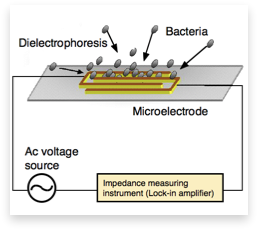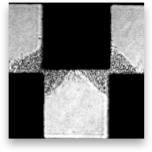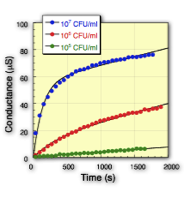Manipulation and detection of bacteria using dielectrophoresis

Dielectrophoresis (DEP) is the electrokinetic motion of dielectrically polarized particles in divergent electric fields and is currently an active area of research in several laboratories. As most biological cells and macro-molecules behave as dielectric particles in external alternating current (ac) electric fields, DEP has found many useful biotechnological applications including separation, positioning and characterization of biological particles. Rapid and sensitive detection of pathogenic bacteria has been an important concern in various fields such as bioscience research, medical diagnosis and hazard analysis in the food industry.
Conventional bacteria inspection methods, such as the colony counting technique, are well established and reliable. However, they require a rather long time (typically a few days) and therefore cannot provide a rapid diagnosis in case of an emergency. There have been a number of attempts to improve traditional bacteria detection techniques employing electrical phenomena, immunoassay and gene technology.

We developed a new detection technique of biological cells called dielectrophoretic impedance measurement (DEPIM) based on dielectrophoresis. The DEPIM utilizes the positive dielectrophoresis, which attracts polarized particles to the high field region, in order to capture biological cells onto an interdigitated electrode chip in the form of pearl-chains. Higher cell population results in faster formation of the pearl-chains, which bridge over the electrode gap and hence increase the admittance between the electrodes. By monitoring the temporal variation of the electrode impedance or admittance, the cell population can be quantitatively evaluated.

DEPIM can realize fast and simple bacteria inspection by using only electrical phenomena and instruments. The DEPIM can also realize selective detection of biological cells according to their viability or species. It has been also demonstrated that DEPIM sensitivity for yeast (Saccharomyces cerevisiae) detection could be considerably improved by electro-permeabilization or electroporation (EP) under high ac electric field. In the EP-assisted DEPIM (EPA-DEPIM), the electrode conductance abruptly increased in a transient manner due to intracellular ion release from the perforated cells. EPA-DEPIM could quantitatively detect yeast cells in 15 min and E. coli in 3 hours at 100 CFU/ml concentration.
- Rapid microbead-based DNA detection using dielectrophoresis and impedance measurement
EPL, Volume 108, Issue 2, 1 October 2014, Article number 28003 (5 pages)
M. Nakano, Z. Ding, H. Kasahara and J. Suehiro
abstract
- Dielectrophoresis of adenovirus and rotavirus and their impedimetric detection
Sensors and Actuators, B: Chemical (in press)
M. Nakano, Z. Ding, H. Kasahara, R. Obara and J. Suehiro
- A rapid bacteria detection technique utilizing impedance measurement combined with positive and negative dielectrophoresis
Sensors and Actuators, B: Chemical, Volume 181, 2013, Pages 439-445
R. Hamada, H. Takayama, Y. Shonishi, L. Mao, M. Nakano and J. Suehiro
abstract
- Higher throughput of optical detection of bacteria concentrated by negative dielectrophoresis
Proceedings of the International Conference on Sensing Technology, (ICST)2013, Article number 6727658, Pages 275-278
R. Obara, Z. Ding, K. Shinzato, M. Nakano and J. Suehiro
abstract
- Detection of norovirus and rotavirus by dielectrophoretic impedance measurement
Proceedings of the International Conference on Sensing Technology, (ICST)2013, Article number 6727678, Pages 374-378
M. Nakano, R. Obara, Z. Ding and J. Suehiro
abstract
- Three dimensional bacteria concentration by negative dielectrophoresis
Advanced Materials Research, Volume 699, 2013, Pages 251-256
T. Hisajima, L. Mao, K. Shinzato, M. Nakano and J. Suehiro
abstract
- Pretreatment of cell membranes for improved electropermeabilization- assisted dielectrophoretic impedance measurement
Sensors and Actuators, B: Chemical, Volume 173, October 2012, Pages 676-681
M. Nakano, R. Hamada, H. Takayama, Y. Shonishi, T. Hisajima, L. Mao and J. Suehiro
abstract
- Electrical detection of norovirus capsid using dielectrophoretic impedance measurement method
Proceedings of IEEE Sensors, 2012, Article number 6411163 (4 pages)
M. Nakano, T. Hisajima, L. Mao and J. Suehiro
abstract
- Development of rapid oral bacteria detection apparatus based on dielectrophoretic impedance measurement method
IET Nanobiotechnology, Volume 5, Issue 2, June 2011, Pages 25-31
R. Hamada, J. Suehiro, M. Nakano, T. Kikutani and K. Konishi
abstract
- Bacterial detection using a carbon nanotube gas sensor coupled with a microheater for ammonia synthesis by aerobic oxidization of organic components
IET Nanobiotechnology, Volume 3, Issue 2, 2009, Pages 15-22
J. Suehiro, N. Ikeda, A. Ohtsubo and K. Imasaka
abstract
- Fabrication of bio/nano interfaces between biological cells and carbon nanotubes using dielectrophoresis
Microfluidics and Nanofluidics, Volume 5, Number 6, December 2008, Pages 741-747
J. Suehiro, N. Ikeda, A. Ohtsubo and K. Imasaka
abstract
- Selective detection of bacteria by a dielectrophoretic impedance measurement method using an antibody-immobilized electrode chip
Sensors and Actuators B: Chemical, Volume 119, Issue 1, 24 November 2006, Pages 319-326
J. Suehiro, A. Ohtsubo, T. Hatano and M. Hara
abstract
- Improvement of electric pulse shape for electropermeabilization-assisted dielectrophoretic impedance measurement for high sensitive bacteria detection
Sensors and Actuators B: Chemical, Volume 109, Issue 2, 14 September 2005, Pages 209-215
J. Suehiro, T. Hatano, M. Shutou and M. Hara
abstract
- High sensitive detection of biological cells using dielectrophoretic impedance measurement method combined with electropermeabilization
Sensors and Actuators B: Chemical, Volume 96, Issues 1-2, 15 November 2003, Pages 144-151
J. Suehiro, M. Shutou, T. Hatano and M. Hara
abstract
- Dielectrophoretic filter for separation and recovery of biological cells in water
IEEE Transactions on Industry Applications, Volume 39, Issue 5, Sept.-Oct. 2003 Pages 1514 - 1521
J. Suehiro, G. Zhou; M. Imamura, and M. Hara
abstract
- Selective detection of specific bacteria using dielectrophoretic impedance measurement method combined with an antigen–antibody reaction
Journal of Electrostatics, Volume 58, Issues 3-4 , June 2003, Pages 229-246
J. Suehiro, D. Noutomi, M. Shutou and M. Hara
abstract
- Selective detection of viable bacteria using dielectrophoretic impedance measurement method
Journal of Electrostatics, Volume 57, Issue 2, February 2003, Pages 157-168
J. Suehiro, R. Hamada, D. Noutomi, M. Shutou and M. Hara
abstract
- Quantitative estimation of biological cell concentration suspended in aqueous medium by using dielectrophoretic impedance measurement method
J. Phys. D: Appl. Phys., Vol.32, pp.2814-2820, 1999
J. Suehiro, R. Yatsunami, R. Hamada and M. Hara
abstract
- The dielectrophoretic movement and positioning of a biological cell using a three-dimensional grid electrode system
J. Phys. D: Appl. Phys., Vol.31, pp.3298-3305, 1998
J. Suehiro and R. Pethig
abstract
> Back to the Research Top